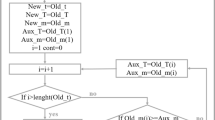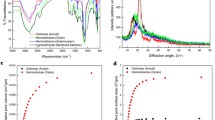Abstract
Thermal diffusivities of Aspen wood were experimentally determined and subsequently incorporated into a theoretical model to establish the effect of transient temperature variation within a solid substrate during acid catalyzed hydrolysis of hemicellulose. The simulation results were analyzed to evaluate the impact of particle size on hemicellulose hydrolysis. Total xylose yield was found to decrease for increasing chip size and this effect was intensified by increasing reaction temperature. Quantitative criteria were established for assessment of transient temperature effect on xylose yield and reaction time at various reaction conditions.
Similar content being viewed by others
Abbreviations
- A:
-
“easy” hemicellulose
- B:
-
“difficult” hemicellulose
- C:
-
xylose
- D:
-
decomposition products
- Ci :
-
concentration
- kd :
-
rate constant for decomposition
- kdo :
-
frequency factor for decomposition
- H:
-
acid concentration (wt%)
- nd :
-
acid concentration exponent
- Ed :
-
activation energy for decomposition
- R:
-
gas constant
- T:
-
absolute temperature
- T:
-
reaction time
- X:
-
position in slab]as measured from center
- Z:
-
X/L
- Ts :
-
steam temperature
- To :
-
initial temperature
- p :
-
density
- K:
-
thermal conductivity
- H:
-
heat transfer coefficient
- L:
-
half-thickness of slab
- Nu:
-
Nusselt number = hL/k
- α:
-
thermal diffusivity = k/pCp
- Ln :
-
Eigen value as defined by Eq. (7)
- Φ:
-
dimensionless temperature = (T - TS)/(TO - Ts)
- τ:
-
dimensionless time = αt/L2
- CHT:
-
chip half thickness
References
Beck, S. R. and Wang, T. (1982), AIChE National Meeting, Orlando, FL.
Bhandari, N., McDonald, D. G., and Bakhchi, N. N. (1984),Biotechnol. Bioeng. 26, 320.
Brennan, A. H., Schell, D. J., Hoagland, W., and Werdene, P. G. (1987), 9th Symp. for Biotechnol., Boulder, CO.
Cahela, D. R., Lee, Y. Y., and Chambers, R. P. (1983),Biotechnol. Bioeng. 25, 3–17.
Kim, S. B. and Lee, Y. Y. (1986),Biotechnol. Bioeng. Symp. 17, 71–84.
Kobayashi, T. and Sakai, Y. (1956),Bull. Agr. Chem. Soc. Japan,20, 1.
Fan, L. T., Lee, Y. H., and Breadmore, D. H. (1980),Biotechnol. Bioeng. 22, 177.
Kelsey, R. G. and Shafezdah, F. (1980),Biotechnol. Bioeng. 22, 1025.
Grohmann, K., Torget, R., and Himmel, M. (1985),Biotechnol. Bioeng. Symp. 15, 59–80.
Stamm, A. and Harris, E. (1953),Chemical Processing of Wood, Chemical Publishing, 153.
Author information
Authors and Affiliations
Rights and permissions
About this article
Cite this article
Tillman, L.M., Abaseed, A.E., Lee, Y.Y. et al. Effect of transient variation of temperature on acid hydrolysis of aspen hemicellulose. Appl Biochem Biotechnol 20, 107–117 (1989). https://doi.org/10.1007/BF02936476
Issue Date:
DOI: https://doi.org/10.1007/BF02936476




